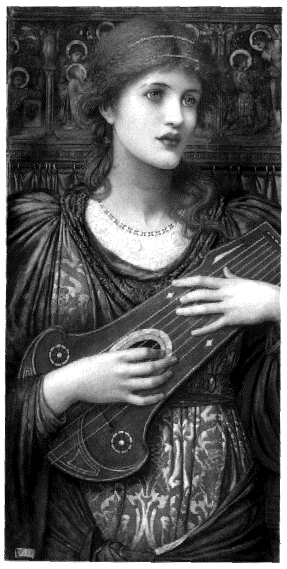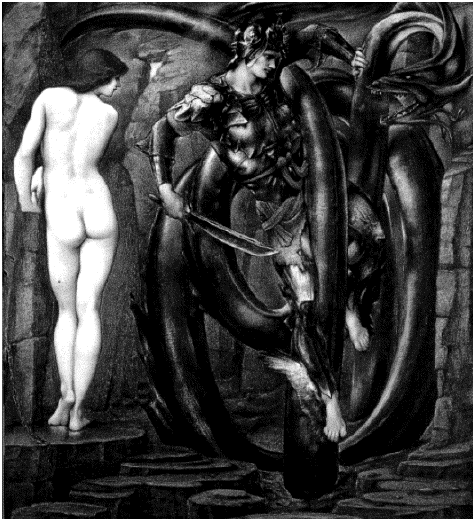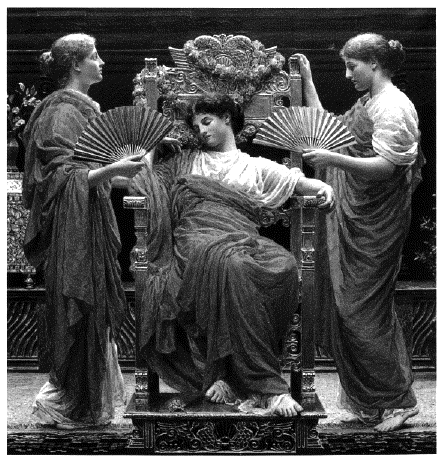Painting
Christopher Wood
(Bulfinch)
 John Melhuish Strudwick sketches an Italianate lute player [see Fig 1, left] and calls it "Thy Music Feintly Falling, Dies Away..." Feintly! Sir Lawrence Alma-Tadena offers a white clad Cleopatra, in her barge, with poop of beaten gold, awaiting lusty Antony, who can be seen just behind the flute player, as she says to Charmian,
John Melhuish Strudwick sketches an Italianate lute player [see Fig 1, left] and calls it "Thy Music Feintly Falling, Dies Away..." Feintly! Sir Lawrence Alma-Tadena offers a white clad Cleopatra, in her barge, with poop of beaten gold, awaiting lusty Antony, who can be seen just behind the flute player, as she says to Charmian, If you find him sad,
Say I am dancing; if in mirth, report
That I am sudden sick.
Robert Braithwaite Martineau (where do they get these names?) paints "The Last Day in the Old Home" --- the feckless son has gambled away the title to the homestead: the landlord is smiling, the mother weeping. Eyre Crowe does factory girls, but they look terribly happy considering they're working in a sweat-shop that would make those of Los Angeles look like paradise. Gabriel Rossetti the Pre-Raphaelite Dante offers us a picture of the his namesake of Divine Comedy fame. Henry Wallis shows Chatterton the poet in a passionate falling- John William Waterhouse likes water nymphs, and lures one of the Argonauts into the springs, where they are springing about, with their lovely straight pale faces, bodies clad in nothing more than water-lilies and dark spring water. She only said, "My life is dreary --- Marcus Stone does ladies in Regency costume reading "The First Love Letter." James McNeill Whistler not only did his mother but also Thomas Carlyle at Craigenputtoch. Wood tells us that Carlyle liked the portrait because his "linen was clean." George Frederick Watts presents Tennyson with droopy eyes, William Powell Frith offers Charles Dickens with droopy moustache. Clarkson Stanfield made some stormy paintings of naval battles, Sir Augustus Wall Callcott paints fishermen in barque and seashore in such detail that you can almost smell the mud and the rotting carp --- while Joseph Mallord William Turner gives vistas of the sea that fifty years before their arrival, anticipates the impressionists. Mr. Wood defines the Victorian period as lasting, as did the good queen, from 1837 to 1901. Wood also tells us that his Dictionary of Victorian Painters lists 11,000 artists --- indicating that the era was "hugely prolific." You can say that again. For those of us who are softies for this lush, garish, tearful, almost pornographic style of art, Victorian Painting is a treasure-pot. There are 500 illustrations which means that for sixty bucks, you get a lush, garish, tearful collection of watercolors, line drawings, and paintings --- some in color --- at 8.33 cents a shot.  Abraham Solomon paints a couple of railroad portraits: a young man in first class making eyes at a young lady while her guardian snoozes in the corner. This, according to Wood, "scandalized the Victorian public," so Solomon quickly redid it with the girl safely tucked in the corner, the old geezer wide awake, conversing animatedly with the young man now transformed into a naval officer. Atkinson Grimshaw portrays Tennyson's Elaine dying of unrequited love, while Sir John Everett Millais paints Tennyson's Mariana, presented with the lines,
Abraham Solomon paints a couple of railroad portraits: a young man in first class making eyes at a young lady while her guardian snoozes in the corner. This, according to Wood, "scandalized the Victorian public," so Solomon quickly redid it with the girl safely tucked in the corner, the old geezer wide awake, conversing animatedly with the young man now transformed into a naval officer. Atkinson Grimshaw portrays Tennyson's Elaine dying of unrequited love, while Sir John Everett Millais paints Tennyson's Mariana, presented with the lines,
He cometh not," she said;
She said "I am aweary, aweary ---
I would that I were dead."
